We start the new week with the following stories...
Be safe out there!
Tom
Massive foam incident in Spirit’s hangar at Detroit Metro Airport
Author: Melanie Kraft
Fire suppression system was accidentally triggered at Spirit Airlines maintenance hangar at Detroit Metropolitan Wayne County Airport.
Spirit Airlines’ Independence Day took an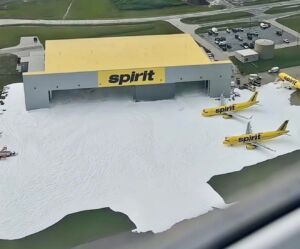 unexpected twist when the fire suppression system at its Detroit Metro Airport maintenance hangar was accidentally triggered, unleashing a massive foam discharge.
unexpected twist when the fire suppression system at its Detroit Metro Airport maintenance hangar was accidentally triggered, unleashing a massive foam discharge.
The hangar doors were open at the time, allowing the foam to spill onto the adjacent ramp area.
The incident, likely caused by a lightning storm that passed through around 5 p.m. local time on July 4th, 2025, affected an Airbus A321 and A320 inside the hangar, along with three additional aircraft parked outside.
The foam, while designed to extinguish fires, poses significant risks to aircraft. Its chemical composition is often highly corrosive, potentially damaging critical systems including engines, electrical bays, and cabin interiors.
Spirit’s 126,000-square-foot hangar—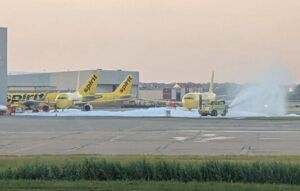 completed in 2017 at a cost of $32 million—serves as a primary maintenance hub for the airline, supporting scheduled and unscheduled maintenance, engine overhauls, and cabin modifications for its Airbus A320 and A321 CEO and Neo fleet.
completed in 2017 at a cost of $32 million—serves as a primary maintenance hub for the airline, supporting scheduled and unscheduled maintenance, engine overhauls, and cabin modifications for its Airbus A320 and A321 CEO and Neo fleet.
The response effort was extensive, with Wayne County Airport Authority (WCAA) fire and rescue crews spending much of the day washing away the foam.
As a result, the affected planes may face extended downtime for inspection and repairs.
Massive foam incident in Spirit’s hangar at Detroit Metro Airport
Single-engine plane crashes at Joliet Regional Airport
By Jessie Molloy
Joliet — Joliet Police and Fire Department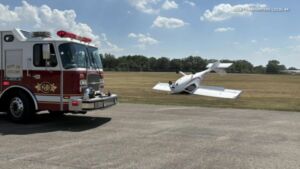 crews responded to a plane crash at the Joliet Regional Airport.
crews responded to a plane crash at the Joliet Regional Airport.
The Joliet Police Department reported on Facebook that officers responded to the airport, 4000 W. Jefferson St., around 3 p.m. on Saturday to assist fire crews when a single-engine aircraft overturned upon landing.
Police report that the aircraft’s pilot was able to safely exit the plane on their own following the incident. No other occupants were on board at the time of the crash, according to Joliet police.
Joliet Firefighters Local 44 also reported the incidents on Facebook, noting that no fire was showing when crews arrived on the scene.
https://www.shawlocal.com/the-herald-news/2025/07/05/single-engine-plane-crashes-at-joliet-regional-airport/
False fire alarm on Ryanair plane in Palma de Mallorca, passengers jump from the wings, 18 injured
Hashtag.al
An unusual incident occurred yesterday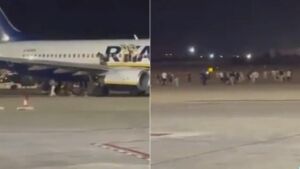 evening at Palma de Mallorca airport in Spain, where a Ryanair flight was affected by a false fire alarm.
evening at Palma de Mallorca airport in Spain, where a Ryanair flight was affected by a false fire alarm.
Panic gripped the passengers, who were urgently evacuated from the plane through emergency exits. Some of them were thrown directly from the wings of the plane onto the runway, sustaining injuries.
According to Spanish authorities, at least 18 people were injured, most with minor injuries. The incident occurred during the preparation phase for takeoff, and fortunately there were no serious injuries.
Authorities have launched investigations to uncover the causes of the false alarm and to assess the management of the situation by the flight crew.
https://www.hashtag.al/en/index.php/2025/07/05/alarm-i-rreme-zjarri-ne-avionin-e-ryanair-ne-palma-de-mallorca-pasagjeret-hidhen-nga-krahet-18-te-plagosur/
JetBlue flight ends up in the grass while taxiing at Orlando International Airport
Flight 488 delayed several hours at MCO
Brandon Hogan, Digital Editor
ORLANDO, Fla. – A JetBlue flight attempting to depart Orlando International Airport on Friday ran off the tarmac while taxiing, according to a JetBlue spokesperson.
to depart Orlando International Airport on Friday ran off the tarmac while taxiing, according to a JetBlue spokesperson.
JetBlue flight 488 to Worcester, Mass., originally scheduled to take off before 10 a.m., was delayed past 2 p.m., according to FlightAware.
Flight 488’s nose gear ended up in the grass after the plane went off the taxiway, the spokesperson said in a statement.
The passengers were deplaned and taken back to the terminal by bus, the statement reads.
“At JetBlue, safety is our highest priority. We are conducting a thorough investigation and will work closely with the appropriate authorities to determine the cause of the incident,” the spokesperson said.
No injuries were reported.
Pilot Makes Emergency Landing on Cape Pogue
By Ethan Genter
No one was hurt Sunday after an engine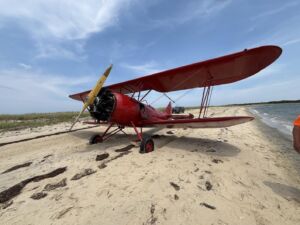 issue forced a sightseeing biplane pilot to make an emergency landing on a Chappaquiddick beach.
issue forced a sightseeing biplane pilot to make an emergency landing on a Chappaquiddick beach.
Just before noon, the bright red biplane piloted by Michael Creato experienced a mechanical problem, and he landed the plane safely on a sandy strip on the bayside of Cape Pogue, witnesses and officials said.
The Federal Aviation Administration confirmed the landing Sunday afternoon, saying the Waco UPF-7 landed on the beach at about 11:50 a.m.. The agency is investigating the incident.
Public safety officials credited Mr. Creato’s expertise in the air and his familiarity with the area as factors in the safe landing.
“I would say there was a very real chance of an awful tragedy,” said Edgartown police Chief Chris Dolby. “Thankfully [it was] averted by the pilot’s superior skill level and the countless hours of flight time and familiarity with that plane.”
Sarah Sullivan, a 21-year-old from New York’s Long Island, was in the plane with her younger cousin Poppy Weiss. Ms. Sullivan had breakfast at the restaurant at the Katama Airfield the previous day, when she saw the sightseeing flights operating out of the airstrip. Though her parents were hesitant to let her go up in the air at first, the family later booked a trip for Sunday.
Ms. Sullivan’s little brothers took a ride first, and then she and Poppy went up after. With Mr. Creato in the cockpit, the cousins saw Nantucket and looked for sharks. Then, suddenly, they heard the engine stop.
“I heard him say ‘Uh oh,’” Ms. Sullivan recounted in a phone interview from the ferry Sunday afternoon.
Mr. Creato told the cousins he was going to take the plane down on the beach, she said. The plane landed with no issue, and everyone walked away injury free.
“It was a really really safe landing,” Ms. Sullivan said. “He was composed the entire time.”
When the plane landed, town officials reached out to Chappy residents to see if they could check on pilot and passengers due to the remoteness of the area, said Alexis Colantonio, whose family has property on Cape Pogue.
Ms. Colantonio, her father Victor, and son Emmett ran down to the beach, and found everyone safe and sound.
“I’m just really happy they were all okay,” she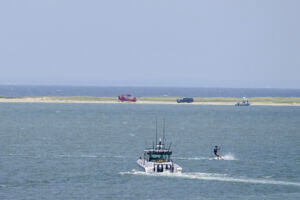 said. “I’ve never landed a plan but it looked like a really beautiful landing.”
said. “I’ve never landed a plan but it looked like a really beautiful landing.”
State police, Edgartown police, Edgartown fire and other first responders all went out to the island off Edgartown to help with the incident. The Trustees of Reservations, which manages oversand vehicle trails on Chappy, said they transported the plane passengers to the Dike Bridge to meet with police.
Mr. Creato did not respond to a phone call Sunday afternoon, but the tour company did put out a statement on social media, saying the pilot made the decision to land on a stretch he was familiar with in order to prioritize the safety of the passengers.
“We thank you all for your kind words and concerns, and we thank Mike for doing what was needed with care, dedication, and years of hard work and training," Classic Aviators wrote on Facebook.
Chief Dolby confirmed that the plane was able to get back up into the air and was flown back to the Katama Airfield.
Classic Aviators has been operating out of the airfield for more than 20 years, flying the classic plane with the open cockpit. Airfield manager Michael Nagle praised Mr. Creato’s landing.
“It’s scary stuff,” he said. “Michael did a great job.”
During the flight, Ms. Sullivan told Mr. Creato that she had never been to Chappy.
“Now I have,” she said with a laugh. “It was incredible.”
https://vineyardgazette.com/news/2025/07/06/pilot-makes-emergency-landing-cape-pogue
Helicopter crashes in Wasatch Mountain State Park; no injuries reported
by: Nick Butts
WASATCH MOUNTAIN STATE PARK, Utah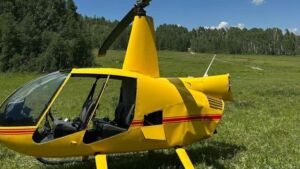 (ABC4) — A mechanical issue forced a sightseeing helicopter to make an emergency landing in Wasatch Mountain State Park, near Midway, around 1:00 p.m. Sunday.
(ABC4) — A mechanical issue forced a sightseeing helicopter to make an emergency landing in Wasatch Mountain State Park, near Midway, around 1:00 p.m. Sunday.
The issue occurred mid-flight, damaging the tail of the chopper. The pilot was able to land it in the Boulder Basin area of the State Park. Two additional passengers were on board, but no one was injured, according to Utah Department of Natural Resources (DNR) Division of Law Enforcement.
Due to the remote location of the landing spot, and lack of cell service, the group had to hike nearly half a mile before finding a privately owned cabin, where they asked a resident to call for help.
Utah DNR Division of Law Enforcement and Wasatch County Sheriff’s Office responded to the call and were able to get everyone safely escorted off the mountain. The incident is currently under review.
https://www.abc4.com/news/local-news/helicopter-crash-wasatch-mountain-state-park/
Wildfire closes Kelowna International Airport, nearby homes evacuated
The wildfire is in the Ellison area to the east of the airport, where police conducted tactical evacuations of nearby homes
By Mike Raptis
A previously out-of-control wildfire that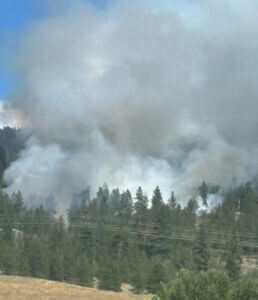 closed Kelowna International Airport on Sunday afternoon is now categorized as being held by the B.C. Wildfire Service.
closed Kelowna International Airport on Sunday afternoon is now categorized as being held by the B.C. Wildfire Service.
The wildfire is in the Ellison area to the east of the airport, affecting Rockface Road, Upper Booth Road and Dead Pine Road. Kelowna RCMP officers conducted tactical evacuations of homes in the area and have asked residents to prepare for a possible evacuation.
The fire is burning uphill toward Postill Lake and several other nearby lakes that have cabins and campsites. Police are advising people in those areas above Ellison to leave as a precaution. The Kelowna Fire Department is currently battling the blaze.
The fire had grown from 0.02 square kilometres (2 hectares) to 0.06 square kilometres (6 hectares) in size, but has since decreased to 0.0431 square kilometres (4.31 hectares), as of 7:00 p.m.
The public is being strongly urged to stay away from the area and emergency services will not allow anyone into the evacuation zone.
The wildfire is likely human caused.
FortisBC has cut off power to homes in the Ellison area at the request of fire officials.
B.C. Minister of Forests Ravi Parmar says he was on a flight to Kelowna on Sunday that was rerouted back to Victoria.
Tara Armstrong, the OneBC MLA for Kelowna-Lake Country-Coldstream, says the Central Okanagan Emergency Operations Centre has been opened and a muster station has been set up to receive evacuees in Lake Country at 3450 Woodsdale Road.
Evacuees can pre-register for basic Emergency Support Services here.
https://vancouversun.com/news/local-news/out-of-control-wildfire-burning-near-kelowna-airport-homes-evacuated
NTSB Prelim: Robinson Helicopter Co R66
Preliminary Weather Data Revealed Conditions, About Two Miles From The Accident Site Were 500 Ft Overcast, And 10 Statute Miles Visibility
Location: Kaparuk, AK Accident Number: ANC25FA044
Date & Time: June 4, 2025, 10:55 Local Registration: N962MD
Aircraft: Robinson Helicopter Co R66 Injuries: 2 Fatal
Flight Conducted Under: Part 135: Air taxi & commuter - Scheduled
On June 4, 2025 about 1055 Alaska daylight time, a Robinson R66 turbine-powered helicopter, N962MD, was substantially damaged when it was involved in an accident near Kaparuk, Alaska. The pilot and passenger were fatally injured. The helicopter was operated as a Title 14 Code of Federal Regulations Part 135 on-demand charter flight.
The helicopter was operated by Pollux Aviation, Wasilla, Alaska, and according to the director of operations, the flight was part of a contract conducting bird research. The purpose of the flight was to scout conditions in the local area, and the next day they planned to relocate to a remote work camp within the North Slope region for three weeks. The pilot was new to the company and flew from Wasilla to Deadhorse Airport (PASC), Deadhorse, Alaska, the day before the accident. The accident flight was his first flight on the North Slope with a passenger.
The Alaskan North Slope is bounded on the north by the Beaufort Sea and runs from the Canadian border to the maritime boundary with Russia in the west. The North Slope region includes a portion of the Arctic National Wildlife Refuge (ANWR) and National Petroleum Reserve-Alaska (NPRA).
Weather conditions at PASC when the accident helicopter departed were reported to be, in part: wind 080° at 6 knots; visibility 10 statute miles; overcast ceiling of 500 feet. The pilot received a weather briefing prior to departure.
According to archived Federal Aviation Administration (FAA) communication data, prior to departure, the accident pilot contacted the Deadhorse Flight Service Station (SCC FSS) specialist on-duty to request a special visual flight rules (SVFR) clearance to depart to the west. The specialist on duty issued the pilot a SVFR clearance and instructed him to report clear of the Class E airspace to the west. The helicopter then departed to the west.
When the helicopter was about 15 miles west of PASC, the pilot informed the SCC FSS specialist that the helicopter was clear of the airport environment to the west. No further radio contact was received from the accident helicopter. According to archived automatic dependent surveillance-broadcast (ADS-B) data, after the helicopter departed PASC, it proceeded west to an area about 25 miles away, and the altitude ranged from about 300 to 600 ft mean sea level (msl). The data ends at an altitude of 575 ft msl, and during a left turn to the southwest.
After an emergency locater transmitter (ELT) signal was received and attempts to reach the crew were unsuccessful, a North Slope Borough (NSB) Search and Rescue Sikorsky S-92 helicopter was dispatched from Utqiagvik (formerly Barrow), Alaska to search for the helicopter. NSB search and rescue crews found the helicopter wreckage about 25 miles west of Deadhorse in an area of flat, snow-covered, featureless terrain.
A review of preliminary weather data revealed conditions, about two miles from the accident site were 500 ft overcast, and 10 statute miles visibility. On June 5, an investigator from the National Transportation Safety Board's (NTSB) Alaska Regional Office traveled to Deadhorse, but travel to the accident site by helicopter was delayed due to poor weather conditions until June 7. Once on scene, the NTSB investigator documented the helicopter wreckage before recovery efforts began.
An initial examination of the helicopter wreckage revealed that all the helicopter’s components were found at the accident site. The main wreckage came to rest about 11 feet from the initial impact point, and it showed significant down-stroking impact damage. One main rotor blade was found about 140 ft to the left of the main wreckage, and the other main rotor blade remained attached to the helicopter’s main rotor hub.
Continuous poor weather conditions delayed the wreckage recovery until June 9. The wreckage was initially slung by helicopter to PASC, then transported to Anchorage for further examination and testing. A detailed wreckage examination is pending.
FMI: www.ntsb.gov
NTSB Final Report: Just Highlander
Pilot’s Failure To Maintain Directional Control While Landing With A Crosswind.
Location: Rusk, Texas Accident Number: CEN25LA137
Date & Time: March 26, 2025, 10:23 Local Registration: N7770J
Aircraft: Just Highlander Aircraft Damage: Substantial
Defining Event: Loss of control on ground Injuries: 1 None
Flight Conducted Under: Part 91: General aviation - Flight test
Analysis: The pilot reported that he was attempting to land with a crosswind, and upon touchdown, a gust of wind lifted the right wing. The pilot attempted to correct with full right aileron but was unsuccessful. The airplane’s left wing contacted the ground, and the airplane came to rest inverted resulting in substantial damage to both wings, the fuselage, and the vertical stabilizer.
The pilot stated that there were no preimpact mechanical malfunctions or failures of the airplane that would have precluded normal operation.
Probable Cause and Findings: The National Transportation Safety Board determines the probable cause(s) of this accident to be -- The pilot’s failure to maintain directional control while landing with a crosswind.
FMI: www.ntsb.gov
NTSB Final Report: Wolstenholme Dennis Pietenpol Air Camper
After Several Failed Attempts To Start The Engine With The Electric Starter, The Pilot Decided To “Hand Prop” The Engine
Location: Tullahoma, Tennessee Accident Number: ERA25LA077
Date & Time: December 12, 2024, 11:35 Local Registration: N161DW
Aircraft: Wolstenholme Dennis Pietenpol Air Camper Aircraft Damage: Substantial
Defining Event: Collision with terr/obj (non-CFIT) Injuries: 1 None
Flight Conducted Under: Part 91: General aviation - Personal
Analysis: The pilot had just finished fueling the airplane and was trying to start the engine. After several failed attempts to start the engine with the electric starter, the pilot decided to “hand prop” the engine. The pilot subsequently placed standard, low-profile general aviation wheel chocks under the wheels, but did not tie down or otherwise secure the airplane. Additionally, the pilot did not secure anyone to assist him and there was no qualified pilot seated in the airplane during his attempt to start the engine. As soon as the engine started, and the airplane’s wheels rolled over the chocks, and the airplane taxied into a closed hangar door, resulting in substantial damage to the fuselage and both wings, and damaging the hangar doors.
Following the accident, the pilot stated that he had not previously received any formal training for hand propping an airplane, but that a mechanic had shown him how to do it. He was not aware of recommended precautions like having a qualified and trained pilot at the controls or tying the airplane down.
Probable Cause and Findings: The National Transportation Safety Board determines the probable cause(s) of this accident to be -- The pilot’s failure to adequately secure the airplane before hand-propping the engine. Contributing was the pilot’s lack of training in hand-propping procedures.
FMI: www.ntsb.gov
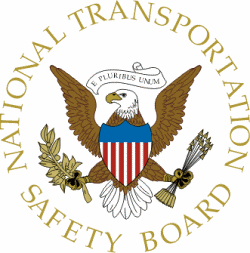
Today in History
63 Years ago today: On 7 July 1962 Alitalia flight AZ771, a Douglas DC-8-43, impacted a mountain near Junnar, India, killing all 94 occupants.
| Date: | Saturday 7 July 1962 |
| Time: | 00:10 |
| Type: | Douglas DC-8-43 |
| Owner/operator: | Alitalia |
| Registration: | I-DIWD |
| MSN: | 45631/160 |
| Year of manufacture: | 1962 |
| Total airframe hrs: | 964 hours |
| Engine model: | Rolls-Royce Conway 508-12 |
| Fatalities: | Fatalities: 94 / Occupants: 94 |
| Other fatalities: | 0 |
| Aircraft damage: | Destroyed, written off |
| Category: | Accident |
| Location: | 11 km NW of Junnar - India |
| Phase: | En route |
| Nature: | Passenger - Scheduled |
| Departure airport: | Bangkok-Don Muang International Airport (BKK/VTBD) |
| Destination airport: | Bombay-Santacruz Airport (BOM/VABB) |
| Confidence Rating: | Accident investigation report completed and information captured |
Narrative:
Alitalia flight AZ771, a Douglas DC-8-43, impacted a mountain near Junnar, India, killing all 94 occupants.
Alitalia flight 771 was a scheduled flight from Sydney (Australia) to Rome (Italy) via Darwin (Australia), Singapore, Bangkok (Thailand), Bombay (India), Karachi (Pakistan) and Tehran (Iran). It departed Bangkok Airport for Bombay-Santacruz Airport at 15:16 UTC (22:16 local time). At 18:20 UTC (22:50 local time) the crew contacted Bombay Approach and received clearance to descend from FL350 to FL200. Five minutes later further clearance was given to 4000 feet. In preparation for a runway 27 approach, the crew reported that they would make a 360 degrees turn over the Outer Marker. Last radio contact was at 18:39 (00:09 local time). The DC-8 had descended below minimum safe altitude and struck the Davandyachi Hill at an elevation of approximately 3600 ft amsl (1098 m).
PROBABLE CAUSE: "The accident was attributed to a navigation error which led the pilot to believe that he was nearer his destination than he actually was and, therefore, caused him to make a premature descent in instrument conditions for a straight-in approach to land at night. The aircraft consequently, crashed into high terrain. Contributing causes were: 1) Failure on the part of the pilot to make use of the navigational facilities available in order to ascertain the correct position of the aircraft.
2) Infringement of the prescribed minimum safe altitude. 3) Unfamiliarity of the pilot with the terrain on the route."
